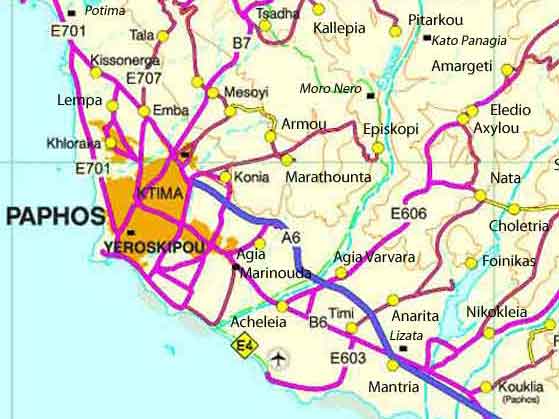|
|
Kissonerga (Greek : )is a small village in South West Cyprus, about 10 miles north of Paphos. It has very little in the way of amenities, and is surrounded by pomegranate plantations. If you travel on the main road from Paphos towards Coral Bay, after about seven kilometres you will come to Kissonerga. Along the coast road are several hotels, mini-markets, numerous bars and taverns, as well as small complexes of shops mainly catering for tourists. Away from the coast road, Kissonerga village has a main street where there are restaurants, several mini-markets, a bank, two coffee shops (one of which also operates as a sub post office), a bookshop, florist, chemist, a couple of hairdressers, and more. There is also an internet café, which, curiously enough, doesn’t have an internet connection or any computers. At the far end of the main street, opposite the school, which caters for children from nursery age up to 11 years old, there is a communal area which is mainly used as a playground. Bordering on this area are two monuments dedicated to two young men of the village who were members of EOKA (National Organisation of Cypriot Fighters) and who died for their cause. EOKA started a guerrilla campaign against British colonial rule aimed at union with Greece (Enosis) on 1st April 1955. The campaign lasted until 1959 and caused the deaths of more Greek Cypriot civilians than the total of British killed. It created civil strife and mistrust between the two Cypriot communities. Across the road from the playground is the Church of the Transfiguration and not far from this church are the ruins of a tiny chapel dedicated to Saints Zinovia and Filonilli. These two saints accompanied St Paul to Paphos to help spread Christianity. They died and were buried in Kissonerga. To the north of Kissonerga a rare settlement of the Chalcolithic culture characteristic of the Paphos region, which lasted for about a millennium (3500-2500 BCE), has been discovered. The site is an important settlement and evidence suggests that a powerful fertility goddess was worshipped here who protected childbirth and infants. Among the many artefacts found there are a clay figurine of a woman seated on a stool in the act of childbirth and a unique limestone statuette representing a pregnant woman with a phallic neck. The village consisted of clusters of round houses (some of which have been reconstructed on the site) built of stone and mud and with no defensive walls around it. Its inhabitants lived on hunting, fishing, herding and the gathering and growing of various plants. They made tools in stone, bone and deer antler and knew pottery, stone and wood carving, weaving, and basketry. They also used a few small copper objects. Experts’ analyses of human remains found at the site confirm the existence of thalassaemia, a blood disorder that affects the production of haemoglobin and results in severe anaemia. The disorder is passed from parent to child via genes and is the most common inherited blood disorder in the world. Thalassaemia is particularly prevalent in people from Mediterranean countries and a broad region extending across the Middle East and South East Asia. To the north of Kissonerga a new football stadium has recently been built in amongst the numerous plantations of bananas. Before the advent of EU directives, Kissonerga was awash with these thriving plantations, but now, sadly, many of them have fallen into decay as the bananas produced did not fit the exacting criteria that allowed them to be exported within the EU. However, you can still see many blocks of these plantations with their characteristic blue bags rustling in the breeze. Beware of the spiders that love to lurk here though! Among the many and varied establishments to be found in Kissonerga, you may come across a horse-riding centre and the boat yard which sells, repairs and services boats of all shapes and sizes. See also Retrieved from "http://en.wikipedia.org/
 |
|
||||||||||||||
